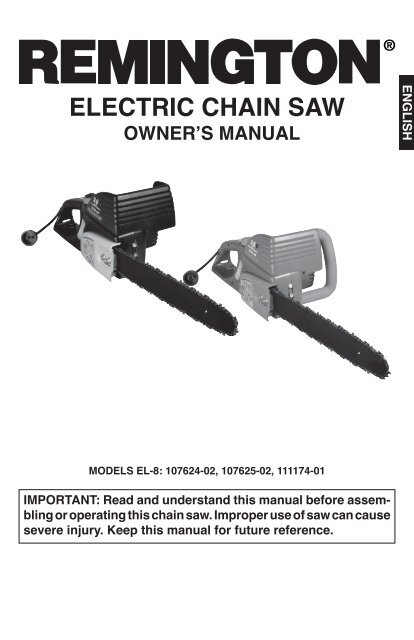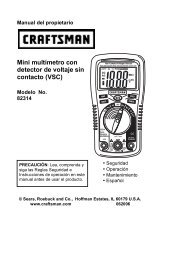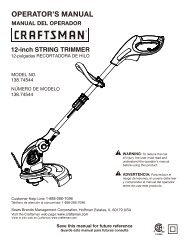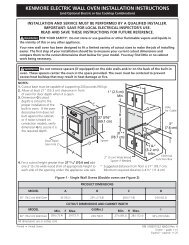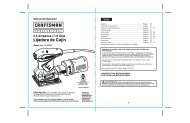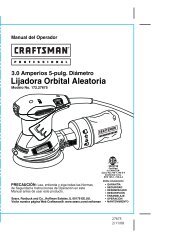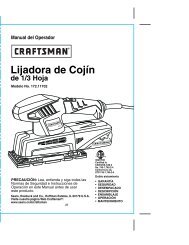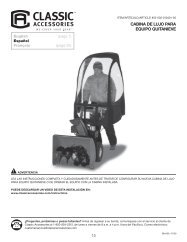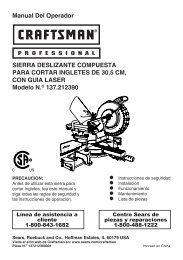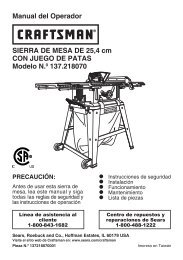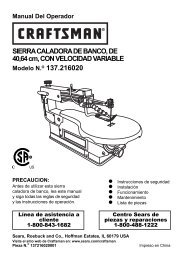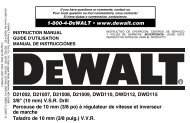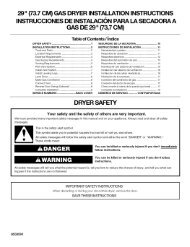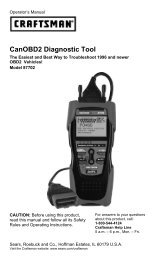electric chain saw - Sears
electric chain saw - Sears
electric chain saw - Sears
You also want an ePaper? Increase the reach of your titles
YUMPU automatically turns print PDFs into web optimized ePapers that Google loves.
®ELECTRIC CHAIN SAWOWNER’S MANUALENGLISHMODELS EL-8: 107624-02, 107625-02, 111174-01IMPORTANT: Read and understand this manual before assemblingor operating this <strong>chain</strong> <strong>saw</strong>. Improper use of <strong>saw</strong> can causesevere injury. Keep this manual for future reference.
CONTENTSIMPORTANT SAFETY INFORMATION ...............................................................................4Before Operating Saw ........................................................................................................................4While Operating Saw ..........................................................................................................................4Kickback .............................................................................................................................................5Maintenance and Storage of Chain Saw ............................................................................................6UNPACKING ........................................................................................................................6PRODUCT IDENTIFICATION ..............................................................................................7CHAIN SAW NAMES AND TERMS .....................................................................................8ASSEMBLY ..........................................................................................................................9SAW CHAIN TENSION ADJUSTMENT ............................................................................10OPERATING CHAIN SAW .................................................................................................11Filling Oil Tank ..................................................................................................................................11Oiling Chain ......................................................................................................................................11Extension Cords ...............................................................................................................................11Cutting with the Chain Saw ..............................................................................................................12Felling a Tree (Cutting Down a Tree) ...............................................................................................12Limbing a Tree ..................................................................................................................................14Bucking a Log ...................................................................................................................................14Trimming a Tree (Pruning)................................................................................................................15CLEANING AND MAINTENANCE ....................................................................................16Cleaning Saw Body ..........................................................................................................................16Care of Guide Bar ............................................................................................................................16Sharpening Saw Chain .....................................................................................................................16Replacing Saw Chain .......................................................................................................................17STORAGE ..........................................................................................................................18TECHNICAL SERVICE ......................................................................................................18REPLACEMENT PARTS AND ACCESSORIES ...............................................................18REPAIR SERVICE .............................................................................................................18Warranty Service ..............................................................................................................................18Non-Warranty Service ......................................................................................................................18TROUBLESHOOTING .......................................................................................................19WARRANTY INFORMATION .............................................................................................20ILLUSTRATED PARTS BREAKDOWN/ ............................................................................63Models/Modelos/Modèles 107624-02 ..............................................................................................64ILLUSTRATED PARTS BREAKDOWN .............................................................................65Models/Modelos/Modèles 107625-02 & 111174-01 ..........................................................................66PARTS CENTRAL .............................................................................................................67ENGLISH3 www.remingtonpowertools.com
IMPORTANT SAFETY INFORMATIONWARNING: When using an <strong>electric</strong><strong>chain</strong> <strong>saw</strong>, basic safety precautionsshould always be followed to reduce therisk of fire, <strong>electric</strong> shock, and injury topersons, including the following:READ ALL INSTRUCTIONS.Make sure you read and understand all instructionsin Important Safety Informationon pages 3 through 5. Improper use of this<strong>chain</strong> <strong>saw</strong> can cause severe injury or deathfrom fire, <strong>electric</strong>al shock, body contactwith moving <strong>chain</strong>, or falling wood.BEFORE OPERATING SAW1. Read and understand this owner’s manual beforeoperating <strong>chain</strong> <strong>saw</strong>.2. Watch what you are doing. Use common sense.Do not operate <strong>saw</strong> when you are tired.3. Use <strong>chain</strong> <strong>saw</strong> for cutting wood only. Do not use<strong>chain</strong> <strong>saw</strong> for purpose not intended. Do not usefor cutting plastic, masonry, etc.4. Only well-instructed adults should operate <strong>chain</strong><strong>saw</strong>. Never allow children to operate <strong>chain</strong> <strong>saw</strong>.5. Use only <strong>electric</strong>al voltage noted on model plateof <strong>chain</strong> <strong>saw</strong>.6. Use only extension cords marked for outdoor use.See page 10 for extension cord requirements.7. Do not operate <strong>chain</strong> <strong>saw</strong>• while under the influence of alcohol, medication,or drugs• in rain or in damp or wet areas• where highly flammable liquids or gases arepresent• if <strong>saw</strong> is damaged, adjusted wrong, or not fullyand securely assembled• if trigger does not turn <strong>saw</strong> on and off. Chainmust stop moving when you release trigger.Have faulty switch replaced by authorized servicecenter (see Technical Service, page 16).• while in a hurry• while in tree or on a ladder unless trained todo so8. Wear snug-fitting clothes when operating <strong>chain</strong><strong>saw</strong>. Do not wear loose clothing or jewelry. Theycan get caught in moving <strong>saw</strong> <strong>chain</strong>.9. Wear the following safety gear when operating<strong>chain</strong> <strong>saw</strong>.• heavy-duty gloves (wear rubber gloves whenworking outdoors)• steel-toed safety footwear with non-skid soles• eye protection such as safety glasses, goggles,or face screen• safety hard hat• ear mufflers or ear plugs• hair covering to contain long hair• face or dust mask (if working in dusty areas)10. Before cutting, always provide the following:• clear work area• secure footing• planned retreat path from falling tree11. Inspect tree before cutting down. Make sure there areno dead limbs or branches that may fall on you.12. To reduce the risk of <strong>electric</strong> shock, this <strong>saw</strong> has apolarized plug (one blade is wider than the other).This plug will fit in a polarized outlet only oneway. If the plug does not fit fully in the outlet ofyour extension cord, reverse the plug. If it stilldoes not fit, a polarized extension cord will benecessary. Do not change the plug in any way.WHILE OPERATING SAW1. Stay alert. Use common sense while operating<strong>chain</strong> <strong>saw</strong>.2. Keep work area clean. Cluttered areas inviteinjuries.3. Be aware of extension cord while operating <strong>chain</strong><strong>saw</strong>. Be careful not to trip over cord. Keep cordaway from <strong>chain</strong> and operator at all times.4. Keep children, animals, and bystanders awayfrom <strong>chain</strong> <strong>saw</strong> and extension cord. Only <strong>chain</strong><strong>saw</strong> user should be in work area.5. Do not cut down a tree unless you are trained orhave expert help.6. If two or more persons perform bucking and fellingoperations at the same time, provide plentyof distance between operations. Provide distanceof at least twice the height of tree being felled.7. Secure wood you are cutting by using clamps orchocks.8. Grip <strong>chain</strong> <strong>saw</strong> firmly with both hands. Neveroperate <strong>chain</strong> <strong>saw</strong> with one hand. Never use handguard as handle.9. Keep finger off trigger until ready to make cut.10. Before starting <strong>chain</strong> <strong>saw</strong>, make sure <strong>chain</strong> is nottouching anything.11. To guard against <strong>electric</strong>al shock, avoid bodycontact with grounded objects such as pipes,fences, and metal posts.12. Keep all parts of body away from <strong>chain</strong> when<strong>saw</strong> is running.13. Do not force <strong>chain</strong> <strong>saw</strong> while cutting. Apply lightpressure. It will do the job better and safer at therate for which it was intended.www.remingtonpowertools.com4
IMPORTANT SAFETY INFORMATION14. Cut small brush and saplings with extreme care.Slender material may catch in <strong>chain</strong> and bewhipped toward you. This could also pull youoff balance.15. When cutting limb or tree trunk that is undertension, use extreme caution. Be alert for woodspringing back. When wood tension is released,limb could spring back and strike operator causingsevere injury or death.16. Carry <strong>chain</strong> <strong>saw</strong> from one place to another• with <strong>saw</strong> stopped and unplugged• by holding front handle (never use hand guardas handle)• with finger off trigger• with guide bar and <strong>chain</strong> to rearWARNING: This product containschemicals known to the State of Californiato cause cancer or birth defects,or other reproductive harm.WARNING: Some dust created bypower sanding, <strong>saw</strong>ing, grinding, drilling,and other construction activitiescontains chemicals known (to the stateof California) to cause cancer, birth defects,or other reproductive harm. Someexamples of these chemicals are:• lead from lead-based paints• crystalline silica from bricks and cementand other masonry products• arsenic and chromium from chemically-treatedlumberYour risk from these exposures varies,depending on how often you do thistype of work. To reduce your exposureto these chemicals: work in a well ventilatedarea, and work with approved safetyequipment, such as those dust masksthat are specially designed to filter outmicroscopic particles.KICKBACKWARNING: Kickback may occur whenthe nose or tip of the guide bar touchesan object, or when the wood closes inand pinches the <strong>saw</strong> <strong>chain</strong> in the cut.Tip contact in some cases may cause alightning fast reverse reaction, kicking theguide bar up and back towards the operator.Pinching the <strong>saw</strong> <strong>chain</strong> along the topof the guide bar may push the guide barrapidly back towards the operator. Eitherof these reactions may cause you to losecontrol of the <strong>saw</strong> which could result inserious injury to user.Kickback Safety Devices On This SawThis <strong>saw</strong> has a low-kickback <strong>chain</strong> and reducedkickback guide bar. Both items reduce the chance ofkickback. Kickback can still occur with this <strong>saw</strong>.Follow assembly instructions on page 9. Do notremove front hand guard. Do not replace front handguard with substitute.The following steps will reduce the risk of kickback.• Use both hands to grip <strong>saw</strong> while <strong>saw</strong> is running.Use firm grip. Thumbs and fingers must wraparound <strong>saw</strong> handles.• Keep all safety items in place on <strong>saw</strong>. Make surethey work properly.• Do not overreach or cut above shoulder height.• Keep solid footing and balance at all times.• Stand slightly to left side of <strong>saw</strong>. This keeps yourbody from being in direct line with <strong>chain</strong>.• Do not let guide bar nose touch anything when<strong>chain</strong> is moving (see Figure 1).DirectionDo Not Let Guide BarTouch HereENGLISH90° QuadrantFigure 1 - Kickback Hazard Example: Do NotLet Nose of Guide Bar Touch Object WhileChain is Moving5 www.remingtonpowertools.com
IMPORTANT SAFETY INFORMATION• Never try cutting through two logs at same time.Only cut one log at a time.• Do not bury guide bar nose or try plunge cut (boringinto wood using guide bar nose).• Watch for shifting of wood or other forces that maypinch <strong>chain</strong>.• Use extreme caution when reentering a previous cut.• Use low-kickback <strong>chain</strong> and guide bar suppliedwith this <strong>chain</strong> <strong>saw</strong>. Only replace these parts with<strong>chain</strong>s and guide bars listed in this manual.• Never use dull or loose <strong>chain</strong>. Keep <strong>chain</strong> sharpwith proper tension.Saw Maintenance and KickbackSafetyFollow maintenance instructions in this manual. Propercleaning of <strong>saw</strong> and <strong>chain</strong> and guide bar maintenancecan reduce chances of kickback. Inspect and maintain<strong>saw</strong> after each use. This will increase the service life ofyour <strong>saw</strong>. Note: Even with proper sharpening, risk ofkickback can increase with each sharpening.MAINTENANCE AND STORAGE OFCHAIN SAW1. Unplug <strong>chain</strong> <strong>saw</strong> from power source• when not in use• before moving from one place to another• before servicing• before changing accessories or attachments,such as <strong>saw</strong> <strong>chain</strong> and guard2. Inspect <strong>chain</strong> <strong>saw</strong> before and after each use.Check <strong>saw</strong> closely if guard or other part hasbeen damaged. Check for any damage that mayaffect operator safety or operation of <strong>saw</strong>. Checkfor alignment or binding of moving parts. Checkfor broken or damaged parts. Do not use <strong>chain</strong><strong>saw</strong> if damage affects safety or operation. Havedamage repaired by authorized service center.3. Maintain <strong>chain</strong> <strong>saw</strong> with care.• Never expose <strong>saw</strong> to rain.• Keep <strong>chain</strong> sharp, clean, and lubricated forbetter and safer performance.• Follow steps outlined in this manual to sharpen<strong>chain</strong>.• Keep handles dry, clean, and free of oil andgrease.• Keep all screws and nuts tight.• Inspect power cord often. If damaged, haverepaired by authorized service center.• Never carry <strong>chain</strong> <strong>saw</strong> by power cord.• Never yank power cord to unplug it.• Keep power cord from heat, oil, and sharpedges.• Inspect extension cords often and replace ifdamaged.4. When servicing, use only identical replacementparts.5. When not in use, always store <strong>chain</strong> <strong>saw</strong>• drain oil after each use and before storing<strong>saw</strong> to prevent oil leakage.• in a high or locked place, out of children’sreach• in a dry place• in a carrying case or with scabbard over guidebarUNPACKING1. Remove all items from carton.2. Check all items for any shipping damage. Ifyou find any damage or if any parts are missing,call Technical Services at 1-800-626-2237 forprompt service.SAVE THESEINSTRUCTIONSwww.remingtonpowertools.com6
PRODUCT IDENTIFICATIONSwitch LockoutOil CapOil Level SightFront Handle with Hand GuardENGLISHRear HandlePower CordGuide Bar NoseCord HitchTriggerChain Tensioning ScrewSaw ChainGuide BarFigure 2 - Chain Saw Model 107624-02Switch LockoutOil CapOil Level SightRear HandleFront Handle with Hand GuardPower CordCord HitchTriggerChain Tensioning KnobSaw ChainGuide BarGuide Bar NoseFigure 3 - Chain Saw Model 107625-02, 111174-017 www.remingtonpowertools.com
CHAIN SAW NAMES AND TERMSBucking Process of cutting a felled tree or log intolengths.Chock Block or wedge used to secure wood frommoving.Felling Process of cutting down a tree.Felling Cut Final cut when felling a tree. Make thiscut on opposite side of tree from notching cut.Front Handle Located at front of <strong>saw</strong> body.Front Hand Guard Shield between front handle andguide bar. Protects left hand while using <strong>saw</strong>.Guide Bar Metal bar that extends from <strong>saw</strong> body.The guide bar supports and guides <strong>chain</strong>.Guide Bar Nose Tip or end of guide bar.Kickback Quick backward and upward motion ofguide bar. Kickback may occur when tip of guide bartouches an object while <strong>chain</strong> is moving. The guidebar will kick up and back towards operator.Limbing Process of cutting limb(s) from a felled tree.Low-Kickback Chain Chain that reduces chance ofkickback as required by ANSI B175.1.Normal Cutting Position Stance used while makingbucking and felling cuts.Notching Cut Notch cut in tree that directs fall of tree.Oiler Control System for oiling guide bar and <strong>chain</strong>.Power Head Chain <strong>saw</strong> without <strong>chain</strong> and guidebar. Also known as <strong>saw</strong> body.Pushback (Kickback, Pinch) Rapid pushback of <strong>chain</strong><strong>saw</strong>. Pushback may occur if <strong>chain</strong> along top of guidebar is pinched, caught, or contacts a foreign object.Rear Handle Handle located at rear of <strong>saw</strong> body.Reduced Kickback Guide Bar Guide bar that reduceschance of kickback.Replacement Chain Chain that complies with ANSIB175.1 when used with a specific <strong>saw</strong>. It may not meetANSI requirements when used with other <strong>saw</strong>s.Saw Chain (Chain) Loop of <strong>chain</strong> having cuttingteeth for cutting wood. The motor drives <strong>chain</strong>. Theguide bar supports <strong>chain</strong>.Spiked Bumper (Spike) Pointed teeth at front of<strong>saw</strong> body beside guide bar. Keep spiked bumper incontact with wood when felling or bucking. It helpsmaintain position of <strong>saw</strong> while cutting.Sprocket Toothed wheel that drives <strong>chain</strong>.Switch Device that completes or interrupts <strong>electric</strong>alcircuit to motor of <strong>saw</strong>.Switch Linkage This device connects switch to trigger.It moves switch when you squeeze trigger.Switch Lockout Device that reduces accidentalstarting of <strong>saw</strong>.Trigger Device that turns <strong>saw</strong> on and off. Squeezingtrigger turns <strong>saw</strong> on. Releasing trigger turns <strong>saw</strong> off.Trimming (Pruning) Process of cutting limb(s) froma living tree.Undercut An upward cut from underside of log orlimb. This is done while in normal cutting positionand cutting with top of guide bar.www.remingtonpowertools.com8
ASSEMBLYNote: Some models are pre-assembled. Assemblyis not needed on these models. See Saw Chain TensionAdjustment.WARNING: Cutting edges on <strong>chain</strong>are sharp. Use protective gloves whenhandling <strong>chain</strong>.IMPORTANT: Do not clamp <strong>chain</strong> <strong>saw</strong> invise during assembly.1. Lay <strong>chain</strong> out flat.2. Loosen and remove guide bar nuts and sprocketcover.3. Loosen and remove drive sprocket screw or removeE-ring from shaft (see Figure 4). Removesprocket support.4. Install guide bar onto <strong>saw</strong> body. Assemble centerslot of guide bar onto guide bar bolts.5. To replace sprocket support, repeat step 3 in reverseorder. Firmly tighten drive sprocket screwwith #2 Phillips screwdriver (if applicable).6. Place <strong>chain</strong> around drive sprocket, along topgroove of guide bar, and around guide bar nose.Note: Make sure cutting edges of <strong>chain</strong> are facingin right direction. Position <strong>chain</strong> so cuttingedges on top of guide bar face guide bar nose (seeFigure 4, and indicator on side cover of <strong>saw</strong>).CAUTION: Do not place <strong>chain</strong> on <strong>saw</strong>backwards. If <strong>chain</strong> is backwards, <strong>saw</strong>will vibrate badly and will not cut.7. Insert tab of sprocket cover into slot on side coverand rotate sprocket cover onto guide bar boltsuntil sprocket cover rests against guide bar.8. Place guide bar nuts, removed in step 2, overguide bar bolts.IMPORTANT: Tighten guide bar nuts finger tightonly.9. Turning <strong>chain</strong> tensioning knob (Model 107625-02, 111174-01) or <strong>chain</strong> tensioning screw(Model 107624-02), adjust position of adjustmentblock until it is aligned and inserted into theround adjusting hole on guide bar (see Figure 4,5and 6). Turning <strong>chain</strong> tensioning knob or <strong>chain</strong>tensioning screw counterclockwise will moveadjustment block to rear of guide bar. Turning<strong>chain</strong> tensioning knob or <strong>chain</strong> tensioning screwclockwise will move adjustment block to frontof guide bar.10. If needed, readjust guide bar nuts to finger tight only.11. Adjust <strong>saw</strong> <strong>chain</strong> tension. Follow steps underSaw Chain Tension Adjustment.ENGLISHDrive SprocketSprocket SupportGuide Bar BoltsDrive Sprocket Screw or E-RingSprocket CoverGuide BarSaw ChainGuide Bar NutsAdjustingHoleTowards Guide Bar NoseCutting EdgeFigure 4 - Assembling Guide Bar and ChainAdjustmentBlockAdjustment BlockE-RingChain Tensioning KnobChain Tensioning ScrewFigure 5 - Turn Chain Tensioning Screw onModel 107624-02Figure 6 - Turn Chain Tensioning Knob on Model107625-02, 111174-019 www.remingtonpowertools.com
LOOSENLOOSENTIGHTENSAW CHAIN TENSION ADJUSTMENTWARNING: Unplug <strong>chain</strong> <strong>saw</strong> frompower source before adjusting <strong>saw</strong><strong>chain</strong> tension.WARNING: Cutting edges on <strong>chain</strong>are sharp. Use protective gloves whenhandling <strong>chain</strong>.TIGHTENModel 107624-02WARNING: Maintain proper <strong>chain</strong>tension always. A loose <strong>chain</strong> will increasethe risk of kickback. A loose <strong>chain</strong>may jump out of guide bar groove. Thismay injure operator and damage <strong>chain</strong>.A loose <strong>chain</strong> will cause <strong>chain</strong>, guide bar,and sprocket to wear rapidly.IMPORTANT!Failure to follow these instructions when tensioning<strong>saw</strong> <strong>chain</strong> will damage <strong>saw</strong> and void the warranty.For additional information call 1-800-626-2237.New <strong>saw</strong> <strong>chain</strong>s will stretch. Check <strong>chain</strong> tensionfrequently when first used and tighten when <strong>chain</strong>becomes loose around guide bar.Turn <strong>chain</strong> tensioning screw clockwiseto tension <strong>saw</strong> <strong>chain</strong> or...TIGHTENTurn <strong>chain</strong> tensioning knob clockwiseto tension <strong>saw</strong> <strong>chain</strong>...Guide BarApprox.5/32"Models 107625-02,and 111174-01If <strong>chain</strong> becomes loose around guidebar, allow <strong>chain</strong> to cool then...Pull <strong>chain</strong> to check tension. Guidelinks should not come out of guidebar groove...TIGHTENLoosen both nuts...Make sure <strong>chain</strong> moves freely aroundguide bar then tighten both nuts.www.remingtonpowertools.com10
OPERATING CHAIN SAWWARNING: Read and understand thisowner’s manual before operating this <strong>saw</strong>.Make certain you read and understand allImportant Safety Information. Improperuse of this <strong>chain</strong> <strong>saw</strong> can cause severeinjury or death from fire, <strong>electric</strong>al shock,or body contact with moving <strong>chain</strong>, orfalling wood.FILLING OIL TANK1. Remove oil cap.2. Fill oil tank with SAE #30 motor oil. Note: Fortemperatures below 30°F, use SAE #10 oil. Fortemperatures above 75°F, use SAE #40 oil.3. Replace oil cap at once. Tighten oil cap firmly forgood seal. This will avoid oil seepage from tank.4. Wipe off excess oil.Note: It is normal for oil to seep when <strong>saw</strong> is not inuse. Empty oil tank after each use to prevent seepage.IMPORTANT: DO NOT USE BAR ANDCHAIN OILOILING CHAINManual Oil SystemAlways check oil level before using <strong>saw</strong>. Do notattempt to operate the oil system while <strong>saw</strong> is inoperation. To oil <strong>chain</strong>, press squeeze bulb. Oil willfeed onto the guide bar and <strong>chain</strong>. Press squeeze bulbat least once before each cut. Check oil level often bylooking at oil sight window (see Figure 7).Oil Sight WindowOil Squeeze BulbOil Sight WindowFigure 8 - Oil Sight Window Location for Model107625-02, 111174-01EXTENSION CORDSUse proper extension cords with this <strong>saw</strong>. Use onlyextension cords marked for outdoor use. The cord mustbe marked with suffix W or W-A following the cordtype designation. Example: SJTW-A or SJTW.Use proper sized cord with this <strong>saw</strong>. Cord must be heavyenough to carry current needed. An undersized cord willcause voltage drop at <strong>saw</strong>. Saw will lose power and overheat.Follow cord size requirements listed below.Cord Length AWG Cord Size25 feet 16 AWG50 feet 16 AWG100 feet 14 AWG150 feet 12 AWGKeep cord away from cutting area. Make sure corddoes not catch on branches or logs during cutting.Inspect cords often. Replace damaged cords.This <strong>chain</strong> <strong>saw</strong> is designed with an extension cord hitchthat prevents the extension cord from being pulled looseduring use. To use, form a loop with the end of theextension cord, insert loop into slot in rear of handle,and place loop over cord hitch (see Figure 9). Gentlypull loop against cord hitch until slack is removed.Plug extension cord into <strong>chain</strong> <strong>saw</strong> cord.ENGLISHFigure 7 - Oil Squeeze Bulb and Oil Sight WindowLocation for Model 107624-02Automatic Oil SystemChain <strong>saw</strong> Model 107625-02, 111174-01 is equippedwith an automatic oiling system. It will provide adequatelubrication to the guide bar and <strong>saw</strong> <strong>chain</strong>. Checkoil level every 15 minutes of cutting time. Oil level canbe seen in oil sight window (see Figure 8).Cord HitchExtension CordPower CordFigure 9 - Looping Extension Cord over CordHitch11 www.remingtonpowertools.com
OPERATING CHAIN SAWCUTTING WITH THE CHAIN SAW1. Connect <strong>saw</strong> to extension cord. Connect extensioncord to power supply.2. Make sure section of log to be cut is not layingon ground. This will keep <strong>chain</strong> from touchingground as it cuts through log. Touching groundwith moving <strong>chain</strong> will dull <strong>chain</strong>.3. Use both hands to grip <strong>saw</strong>. Always use left handto grip front handle and right hand to grip rearhandle. Use firm grip. Thumbs and fingers mustwrap around <strong>saw</strong> handles (see Figure 10).4. Make sure your footing is firm. Keep feet apart.Divide your weight evenly on both feet.5. When ready to make a cut, push the lockoutbutton completely forward with the right thumband squeeze the trigger (see Figure 10). This willturn <strong>saw</strong> on. Releasing trigger will turn <strong>saw</strong> off.Make sure <strong>saw</strong> is running at full speed beforestarting a cut.6. When starting a cut, place moving <strong>chain</strong> againstwood. Hold <strong>saw</strong> firmly in place to avoid possiblebouncing or skating (sideways movement) of <strong>saw</strong>.7. Guide <strong>saw</strong> using light pressure. Do not force<strong>saw</strong>. The motor will overload and can burn out.It will do the job better and safer at the rate forwhich it was intended.8. Remove <strong>saw</strong> from a cut with <strong>saw</strong> running at fullspeed. Stop <strong>saw</strong> by releasing trigger. Make sure<strong>chain</strong> has stopped before setting <strong>saw</strong> down.9. Practice until you can maintain a steady, evencutting rate.Switch Lockout ButtonFELLING A TREE (Cutting Down aTree)WARNING:• Avoid kickback. Kickback can result insevere injury or death. See Kickback toavoid risk of kickback.• Do not fell a tree without ample skill orexpert help.• Keep children, animals, and bystander<strong>saw</strong>ay from area when felling a tree.• If two or more persons perform buckingand felling operations at the sametime, provide ample distance betweenoperations. Provide distance of at leasttwice the height of tree being felled.WARNING: When felling a tree, beaware of your surroundings. Do notendanger any person, strike utility lines,or cause property damage. If tree strikesutility lines, contact utility company atonce.Felling is the process of cutting down a tree. Makesure your footing is firm. Keep feet apart. Divideyour weight evenly on both feet. Follow directionsbelow to fell a tree.Before Felling a Tree1. Before felling, inspect tree. Make sure there areno dead limbs or branches that may fall on you.Study natural lean of tree, location of largerbranches, and wind direction. This will help youjudge which way tree will fall.2. Clear work area around tree.3. Plan and clear a retreat path before felling. Makeretreat path opposite to planned direction of fallof tree and at 45° angle (see Figure 11).Retreat PathTriggerDirection of FallFigure 10 - Lockout Button and TriggerLocation45°TreeRetreat PathFigure 11 - Retreat Path From Treewww.remingtonpowertools.com12
OPERATING CHAIN SAW4. Remove dirt, stones, loose bark, nails, staples, andwire from tree where you will make felling cuts.5. Stay on uphill side when felling tree. Tree couldroll or slide downhill after falling.Felling ProcedureA) Felling NotchA properly placed felling notch will determine directiontree will fall. Place felling notch on side of tree indirection you want tree to fall (see Figure 12). Followdirections below to create a felling notch.1. Make lower notch cut as close to ground aspossible. Hold <strong>saw</strong> so guide bar is horizontal.Cut 1/3 the diameter of tree trunk (see Figure12). Note: Always make this horizontal lowernotch cut first. If you make this cut second, treecan pinch <strong>chain</strong> or guide bar.2. Start upper notch cut the same distance abovefirst cut as first cut is deep.Example: If lower notch cut is eight inches deep,start upper notch cut eight inches above it. Cutdownward at 45° angle. The upper notch cut shouldmeet end of lower notch cut (see Figure 12).3. Remove tree trunk wedge created by notchingcuts.B) Felling Cut1. Make felling cut two inches higher than lowernotch cut and on opposite side of tree (see Figure12). Keep felling cut parallel to lower notch cut.3rd Cut - HingeFelling Cut2"(5 cm)2"(5 cm)Figure 12 - Felling A TreeDirection of Fall2nd Cut - Upper Notch Cut1st Cut - Lower Notch Cut2. Cut towards notch.3. As felling cut nears hinge, tree should begin to fall.Note: If needed, drive wedges into felling cut tocontrol direction of fall. If tree settles back andpinches <strong>chain</strong>, drive wedges into felling cut to remove<strong>saw</strong>. Only use wedges made of wood, plastic,or aluminum. Never use wedge made of steel. Thiscould cause kickback and damage to <strong>chain</strong>.4. When tree begins to fall, quickly• remove <strong>saw</strong> from felling cut• release trigger to turn <strong>saw</strong> off• put <strong>saw</strong> down• exit area using retreat pathENGLISHWARNING: Do not cut all the waythrough tree. Leave about two inchesof tree diameter uncut directly behindfelling notch (see Figure 12). This uncutportion acts as a hinge. The hinge helpskeep tree from twisting and falling inwrong direction.13 www.remingtonpowertools.com
OPERATING CHAIN SAWWARNING: Be alert for falling overheadlimbs. Watch your footing whileexiting area.LIMBING A TREEWARNING: Avoid kickback. Kickbackcan result in severe injury or death. SeeKickback to avoid risk of kickback.WARNING: When cutting limb thatis under tension, use extreme caution.Be alert for wood springing back. Whenwood tension is released, limb couldspring back and strike operator causingsevere injury or death.Limbing is removing branches from a fallen tree.Make sure your footing is firm. Keep feet apart.Divide your weight evenly on both feet. Do notremove larger limbs under tree that support log offground. Remove each limb with one cut (see Figure13). Clear cut limbs from work area often. This willhelp maintain a safe work area.Make sure you start your cut where limb will notpinch <strong>saw</strong> during cutting. To avoid pinching, start cuton freely hanging limbs from above limb. Start cut onlimbs under tension from under limb. If pinch occurs,turn <strong>saw</strong> off, lift limb, and remove <strong>saw</strong>.BUCKING A LOGWARNING: Avoid kickback. Kickbackcan result in severe injury or death. SeeKickback to avoid risk of kickback.WARNING:• If on slope, make sure log will not rolldown hill. Secure log by using woodenstakes. Drive wooden stakes intoground on downhill side of log. Standon uphill side of log while cutting. Logmay roll after cutting.• Never try cutting through two logs atsame time. This could increase the riskof kickback.• While cutting log, never hold log withyour hand, leg, or foot.• While cutting log, never allow anotherperson to hold log.• Turn off and unplug <strong>saw</strong> before movingfrom one place to another.Bucking a log is cutting a log into sections. Makesure your footing is firm. Keep feet apart. Divide yourweight evenly on both feet. When possible, raise logor section off ground. Do this by using limbs, logs,chocks, etc.When cutting through log, maintain control by reducingcutting pressure near end of cut. Do not relax yourgrip on <strong>chain</strong> <strong>saw</strong> handles. Do not let moving <strong>chain</strong>touch ground. Ground will dull moving <strong>chain</strong>. Aftercutting through log, release trigger to turn <strong>saw</strong> offbefore moving <strong>saw</strong>.Follow directions below to buck a log.Entire Length Of Log On GroundCut log from top (see Figure 14).Figure 13 - Limbing A TreeFigure 14 - Bucking Log With Entire LengthOn Groundwww.remingtonpowertools.com14
OPERATING CHAIN SAWLog Supported On One End1. Make first cut on underside of log (see Figure15). Use top of guide bar to make this cut. Cut1/3 through diameter of log. This cut will keepsection from splintering when cut.2. Make second cut directly above first cut. Cutdown to meet first cut. This cut will keep logfrom pinching guide bar and <strong>chain</strong>.Log Supported On Both Ends1. Make first cut from above log (see Figure 16).Cut 1/3 through diameter of log. This cut willkeep section from splintering when cut.2. Make second cut on underside of log, directlyunder first cut. Use top of guide bar to make thiscut. Cut up to meet first cut. This will keep logfrom pinching guide bar and <strong>chain</strong>.TRIMMING A TREE (Pruning)WARNING: Avoid kickback. Kickbackcan result in severe injury or death. SeeKickback to avoid risk of kickback.WARNING: Do not operate <strong>chain</strong><strong>saw</strong> while• in a tree• on a ladder or any other unstable surface• in any awkward positionYou may lose control of <strong>saw</strong> causingsevere injury.WARNING: Do not cut limbs higherthan your shoulders.ENGLISH2nd CutCAUTION: Seek professional help iffacing conditions beyond your ability.2nd Cut1st Cut1st CutFigure 15 - Bucking Log When Log Is SupportedOn One EndFigure 16 - Bucking Log When Log Is SupportedOn Both EndsTrimming a tree is the process of cutting limbs froma living tree. Make sure your footing is firm. Keepfeet apart. Divide your weight evenly on both feet.Follow directions below to trim a tree.1. Make first cut six inches from tree trunk onunderside of limb. Use top of guide bar to makethis cut. Cut 1/3 through diameter of limb (seeFigure 17).2. Move two to four inches farther out on limb.Make second cut from above limb. Continue cutuntil you cut limb off.3. Make third cut as close to tree trunk as possibleon underside of limb stub. Use top of guide bar tomake this cut. Cut 1/3 through diameter of stub.4. Make fourth cut directly above third cut. Cut downto meet third cut. This will remove limb stub.4th Cut - Final Stub Cut2nd Cut - Pruning Cut (to avoid pinching)6"(15 cm)2" to 4"(5 a 10 cm)1st Cut - Pruning Undercut (toavoid splintering)3rd Cut - Stub Undercut (to avoidsplintering)Figure 17 - Cutting A Limb15 www.remingtonpowertools.com
CLEANING AND MAINTENANCENOTICE: Below are instructions for servicingyour <strong>chain</strong> <strong>saw</strong>. Any servicing notmentioned below should be done by anauthorized service center.CLEANING SAW BODYWARNING: Unplug <strong>chain</strong> <strong>saw</strong> frompower source before servicing. Severe injuryor death could occur from <strong>electric</strong>al shockor body contact with moving <strong>chain</strong>.WARNING: Cutting edges on <strong>chain</strong>are sharp. Use protective gloves whenhandling <strong>chain</strong>.WARNING: When cleaning <strong>saw</strong> body,• do not submerge <strong>saw</strong> in any liquids• do not use products that contain ammonia,chlorine, or abrasives• do not use chlorinated cleaning solvents,carbon tetrachloride, kerosene,or gasolineKeep <strong>saw</strong> body clean. Use a soft cloth dampened with amild soap and water mixture. Wipe <strong>saw</strong> body to clean.CARE OF GUIDE BARUneven bar wear causes most guide bar problems.Incorrect sharpening of <strong>chain</strong> cutter and depth gaugesettings often cause this. When bar wears unevenly,it widens guide bar groove (see Figure 18). Thiscauses <strong>chain</strong> clatter and rivet popping. Saw will notcut straight. Replace guide bar if this occurs.Inspect guide bar before sharpening <strong>chain</strong>. A worn ordamaged guide bar is unsafe. A worn or damaged guidebar will damage <strong>chain</strong>. It will also make cutting harder.Guide Bar GrooveNormal Guide Bar Maintenance1. Remove guide bar from <strong>chain</strong> <strong>saw</strong>.2. Remove <strong>saw</strong>dust from guide bar groove periodically.Use putty knife or wire (see Figure 19).3. Clean oil slots after each day of use.4. Remove burrs from sides of guide bar. Use flatfile to make side edges square.Replace guide bar when• bar is bent or cracked• inside groove of bar is badly wornNote: When replacing guide bar, see ReplacementParts and Accessories for proper bar.SHARPENING SAW CHAINWARNING: Unplug <strong>chain</strong> <strong>saw</strong> frompower source before servicing. Severe injuryor death could occur from <strong>electric</strong>al shockor body contact with moving <strong>chain</strong>.WARNING: Cutting edges on <strong>chain</strong>are sharp. Use protective gloves whenhandling <strong>chain</strong>.Keep <strong>chain</strong> sharp. Your <strong>saw</strong> will cut faster and moresafely. A dull <strong>chain</strong> will cause undue sprocket, guidebar, <strong>chain</strong>, and motor wear. If you must force <strong>chain</strong>into wood and cutting creates only <strong>saw</strong>dust with fewlarge chips, <strong>chain</strong> is dull.Flat FileBurrGuide BarGuide BarCleaning Groove With Putty KnifeOil SlotNormal GuideBarGuide Bar WithUneven WearFigure 18 - Guide Bar Cross Section ShowingUneven Bar WearFigure 19 - Guide Bar Maintenancewww.remingtonpowertools.com16
CLEANING ANDMAINTENANCEContinuedItems Needed to Sharpen ChainPurchase these items from your local dealer, hardwarestore, or <strong>chain</strong> <strong>saw</strong> supplies outlet.• 5/32" round file• Depth gauge tool• File guide• Vise• Medium sized flat fileSharpening CuttersUse file guide for 30° filing.1. Adjust <strong>chain</strong> for proper tension (see Saw ChainTension Adjustment).2. Clamp guide bar in vise to hold <strong>saw</strong> steady.Note: Do not clamp <strong>chain</strong>.3. Press 5/32" round file (attached to file guide)into groove between top plate and depth gaugeon <strong>chain</strong>. File guide should rest on both top plateand depth gauge (see Figure 20). Note: File atmidpoint of guide bar.30° Guide MarkFiling DirectionFILE HOLDERFile Guide5/32" Round File4. Hold file guide level. Make sure 30° mark onfile guide is parallel to center of guide bar (seeFigure 20). This will insure that you file cuttersat 30° angle.5. File from inside towards outside of cutter untilsharp. Only file in this one direction (see Figure20). Note: Two or three strokes with file shouldsharpen cutter.6. After each cutter is sharpened, move <strong>chain</strong> forwardto sharpen next cutter. File all cutters onone side of <strong>chain</strong>.7. Move to other side of <strong>chain</strong> and repeat process.Filing Cutter Depth GaugesThe cutter depth gauge clearance is reduced as cuttersare sharpened. After every second or third sharpening,reset cutter depth gauges.1. Place depth gauge tool (.025") firmly across topof two cutters. Make sure depth gauge enters slotin depth gauge tool (see Figure 22).2. Use medium flat file. File depth gauge level withdepth gauge tool.3. Remove depth gauge tool. With flat file, roundoff front corner of cutter depth gauge (see Figure23).After several hand filings, have authorized servicecenter or sharpening service machine sharpen <strong>chain</strong>.This will insure even filing.REPLACING SAW CHAINReplace <strong>chain</strong> when cutters are too worn to sharpen orwhen <strong>chain</strong> breaks. Only use replacement <strong>chain</strong> noted inthis manual. Always include new drive sprocket whenreplacing <strong>chain</strong>. This will maintain proper driving of<strong>chain</strong>. Note: For proper <strong>chain</strong> and drive sprocket,see Replacement Parts and Accessories.Flat FileENGLISHNote: This illustration shows file guide placement and filing directionfor sharpening cutters on left side of <strong>chain</strong>.Figure 20 - File and File Guide Placement OnChainDepth Gauge (leftside of <strong>chain</strong>)GrooveTop Plate (left sideof <strong>chain</strong>)Depth Gauge (rightside of <strong>chain</strong>)GrooveTop Plate (right side of<strong>chain</strong>)Depth Gauge ToolFigure 22 - Depth Gauge Tool On ChainFront CornerDepthGaugeDepth Gauge Slot.025".635 mmRight Side of ChainFigure 21 - Chain Part LocationsFigure 23 - Round Off Front Corner Of DepthGauge17 www.remingtonpowertools.com
REPLACEMENT CHAINSReplacement <strong>saw</strong> <strong>chain</strong>s may be available at yourlocal hardware or home improvement store.The following list gives the specifications for replacement<strong>chain</strong>s.All <strong>chain</strong>s will be .050 gauge, 3/8 pitch.14" <strong>chain</strong>s have 56 drive links16" <strong>chain</strong>s have 58 drive linksYou may also order the replacement <strong>saw</strong> <strong>chain</strong>s fromthe "Online Outlet" at www.remingtonpowertools.com using the part number listed in the illustratedparts list on pages 63-66 of this manual.STORAGEIf storing <strong>saw</strong> for more than 30 days, follow steps below.1. Drain oil tank after each use.2. Remove and clean guide bar and <strong>chain</strong>. Cleanguide bar and <strong>chain</strong> by soaking in petroleumbased solvent or mild soap and water mixture.3. Dry guide bar and <strong>chain</strong>.4. Place <strong>chain</strong> in container filled with oil. This willprevent rust.5. Wipe a thin coating of oil over surface of guide bar.6. Wipe off outside of <strong>saw</strong> body. Do this with soft clothdampened with a mild soap and water mixture.7. Store <strong>chain</strong> <strong>saw</strong>• in a high or locked place, out of children’s reach• in a dry place• in a carrying case or with scabbard over guide barTECHNICAL SERVICEYou may have further questions about assembling,operating, or maintaining this product. If so, youcan visit our Technical Service web site at www.remingtonpowertools.com or contact our TechnicalService Department at 1-800-626-2237 (EnglishOnly). You may also write to:DESA Power ToolsATTN: Technical ServiceP.O. Box 90004Bowling Green, KY 42102-9004When contacting DESA Power Tools, have ready• Your Name• Your Address• Your Phone Number• Model Number of Product• Date of Purchase (Include copy of receipt for writtenrequests).We reserve the right to amend these specificationsat any time without notice. The only warranty applicableis our standard written warranty. We makeno other warranty expressed or implied.REPLACEMENT PARTS ANDACCESSORIESWARNING: Use only replacementparts and accessories described in thismanual. Use of other parts or accessoriescould damage <strong>saw</strong> or injure operator.For original replacement parts and accessories, contactyour nearest Authorized Dealer or AuthorizedService Center for this product. If they can not supplythe part or accessory, contact your nearest PartsCentral listed on page 67. Each Authorized Dealer,Authorized Service Center, and Parts Central isindependently owned and operated.See pages 63 through 66 for an Illustrated Parts List.If you need additional referral information, contact ourTechnical Service Department (see Technical Service).In Canada call 1-800-561-3372 for parts information.REPAIR SERVICENote: Only use original replacement parts. This willprotect your warranty coverage for parts replacedunder warranty.Each Authorized Service Center is independentlyowned and operated.Warranty ServiceIf product requires warranty service, return it to nearestAuthorized Service Center. You must show proof ofpurchase. If faulty materials or workmanship causeddamage, we will repair or replace product withoutcharge. Note: Normal wear, misuse, abuse, neglect, oraccidental damage is not covered under warranty.Non-Warranty ServiceIf product requires service, return it to nearest AuthorizedService Center. Repairs will be billed to youat regular repair list prices.For additional Service Center or warranty information,call 1-800-626-2237 or visit our Technical Serviceweb site at www.remingtonpowertools.com.www.remingtonpowertools.com18
TROUBLESHOOTINGNote: For additional help, visit DESA Power Tools technical service web site at www.remingtonpowertools.com.WARNING: Unplug <strong>chain</strong> <strong>saw</strong> from power source before servicing. Severe injury ordeath could occur from <strong>electric</strong>al shock or body contact with moving <strong>chain</strong>.OBSERVED FAULT POSSIBLE CAUSE REMEDYSaw runs, but does notcutSaw does not cut unlessheavily forced. Cuttingproduces only <strong>saw</strong>dustwith few large chipsSaw runs slow. Saw stallseasilyMotor of <strong>saw</strong> does notrun when you squeezetriggerChain assembled backwards onguide barChain is dullLow power supply voltage1. Switch lockout not pushed forwardin to release trigger2. Extension cord connectionslooseSee AssemblySee Sharpening Saw ChainExtension cord wire size too small. SeeExtension Cords.1. Push switch lockout forward beforesqueezing trigger2. Check cord connectionsENGLISH3. Open line fuse or circuit breaker3. Check line fuse or circuit breakerMotor of <strong>saw</strong> runs, but<strong>chain</strong> does not moveChain does not get oilChain comes off guidebar4. Worn out motor brushes5. Open wiring circuit on <strong>saw</strong>Gear SprocketAll Models1. Clogged oil slot in guide bar2. Oil is too thickModles with Automatic Oiler1. Vent in oil cap clogged2. Filter in oil reservoir clogged3. Pump damaged, do not use <strong>saw</strong>1. Chain is loose2. Guide bar and <strong>chain</strong> not assembledcorrectly4. See authorized service center5. See authorized service centerRemove and inspect gear sprocket fordamage1. Remove guide bar and clean oil slot2. Use correct weight of oil. See FillingOil Tank1. Remove cap and clean vent hole2. Remove filterin oil reservoir andclean3. See authorized service center1. Tighten <strong>chain</strong>. See Saw Chain TensionAdjustment2. See AssemblySaw smokes Saw damaged. Do not use <strong>saw</strong> See authorized service centerSaw leaks oilIt is normal for oil to seep when the Tighten oil cap.<strong>saw</strong> is not in use.Note: Empty oil tank when not in use.19 www.remingtonpowertools.com
WARRANTY INFORMATIONREMINGTON BRAND ELECTRIC CHAIN SAWLIMITED WARRANTIESNEW PRODUCTSStandard WarrantyDESA Power Tools warrants this new product and any parts thereof to be free from defects in materialand workmanship for a period of one (1) year from the date of first purchase from an authorized dealerprovided the product has been maintained and operated in accordance with DESA Power Tools’ warningsand instructions.FACTORY RECONDITIONED PRODUCTSLimited WarrantyDESA Power Tools warrants factory reconditioned products and any parts thereof to be free from defectsin material and workmanship for 90 days from the date of first purchase from an authorized dealer providedthe product has been installed, maintained and operated in accordance with DESA Power Tools’warnings and instructions.TERMS COMMON TO ALL WARRANTIESThe following terms apply to all of the above warranties:• Always specify model number when contacting the manufacturer. To make a claim under this warrantythe bill of sale or other proof of purchase must be presented.• This warranty is extended only to the original retail purchaser when purchased from an authorizeddealer.• This warranty covers the cost of part(s) required to restore this product to proper operating conditionand an allowance for labor when provided by a DESA Power Tools Authorized Service Center. Warrantyparts must be obtained through authorized dealers of this product and/or DESA Power Toolswho will provide original factory replacement parts. Failure to use original factory replacement partsvoids this warranty.• Travel, handling, transportation, diagnostic, material, labor and incidental costs associated with warrantyrepairs, unless expressly covered by this warranty, are not reimbursable under this warranty andare the responsibility of the owner.• Excluded from this warranty are products or parts that fail or become damaged due to misuse, accidents,lack of proper maintenance, tampering, or alterations.• Excluded from this warranty are products purchased for commercial, industrial or rental usage.• This is DESA Power Tools’ exclusive warranty, and to the full extent allowed by law; this expresswarranty excludes any and all other warranties, express or implied, written or verbal and limits theduration of any and all implied warranties, including warranties of merchantability and fitness for aparticular purpose to one (1) year on new products and 90 days on factory reconditioned products fromthe date of first purchase. DESA Power Tools makes no other warranties regarding this product.• DESA Power Tools’ liability is limited to the purchase price of the product, and DESA Power Toolsshall not be liable for any other damages whatsoever under any circumstances including indirect,incidental, or consequential damages.• Some states do not allow limitations on how long an implied warranty lasts or the exclusion or limitationof incidental or consequential damages, so the above limitation or exclusion may not apply to you.• This warranty gives you specific legal rights, and you may also have other rights which vary from stateto state.For information about this warranty contact:Bowling Green, KY 42102-9004800-626-2237 (English Only)www.remingtonpowertools.comwww.remingtonpowertools.comModel _____________________Date Purchased ____________20Industries of Canada, Inc.82 Akron RoadToronto, OntarioM8W1T2416-255-5333Fax: 416-255-5677www.remingtonpowertools.com
NOTES _____________________________________________________________________________________________________________________________________________________________________________________________________________________________________________________________________________________________________________________________________________________________________________________________________________________________________________________________________________________________________________________________________________________________________________________________________ENGLISH21 www.remingtonpowertools.com
NOTES _____________________________________________________________________________________________________________________________________________________________________________________________________________________________________________________________________________________________________________________________________________________________________________________________________________________________________________________________________________________________________________________________________________________________________________________________________www.remingtonpowertools.com22
ILLUSTRATED PARTS BREAKDOWN/DESGLOSE ILUSTRADO DE PARTES/SCHÉMA DESPIÈCESMODELS/MODELOS/MODÈLES 107624-027265341www.remingtonpowertools.com66
PARTS LIST/LISTA DE REPUESTOS/LISTE DES PIÈCESThis list contains replaceable parts used in your <strong>chain</strong><strong>saw</strong>. When ordering parts, be sure to provide the correct model number (from the model plate), then the partnumber and description of the desired part.Esta lista contiene partes reemplazables y que se utilizan en su sierra de cadena. Cuando solicite repuestos, asegúrese de facilitar el número correcto del modelo (dela placa del modelo), luego el número de parte y la descripción de la parte deseada.La présente liste énumère les différentes pièces remplaçables qu’utilise votre scie à chaîne. Pour commander une pièce, ne manquez pas de fournir le bonnuméro de modèle de votre scie (que vous trouverez sur sa plaque signalétique), puis le numéro et la description de la pièce désirée.MODELS/MODELOS/MODÈLE 107624-02KEY NO./ PART NO./NÚMERO NÚMEROCLAVE/N° DE PARTE/ QTY./DE N° DE CANTIDAD/RENVOI PIÈCE DESCRIPTION/DESCRIPCIÓN/DESCRIPTION QTÉ1 099829-04 Shrouded Cord/Cordón con recubrimiento/Corde renforcée 12 122512-01 Kit, Oil Cap/Includes: Oil Cap, Sqeeze Bulb/ 1Juego, tapa del aceite/Incluye:Tapa del tanque de aciete, Depósito de aceiteTrousse, bouchon du réservoir d’huile/Compris: Bouchon du réserVoir, RéserVoir d’huile3 122511-01 Kit, Sprocket Gear/Includes: Bearing, Roller Sprocket, Sprocket, Gear, Drive IIT20DP 1Juego, engranaje del piñón/Incluye: Rodamiento de la rueda dentada del rodillo,Rueda dentada, Engranaje impulsor IIT 20DPTrousse, engrenages du pignon/Compris: Palier, pignon, Pignon, Engrenage d’entraînement IIT 20DP4 122515-01 Kit, Sprocket Support/Includes: Sprocket Support, Shoulder Screw Pan-HD,E-Ring 1Juego, soporte del piñón/Incluye: Soporte de la rueda dentada, Tornillo cabeza redondeada con tope- HD,Anillo ETrousse, support de pignon/Compris: Support de pignon, Vis à épaulement - HD, Joint en E5 108640-01 Kit, Sprocket Cover/Includes: Sprocket Cover Assembly, Guide Bar Nut (2) 1Juego, cubre-piñón/Incluye: Conjunto tapa de la rueda dentada, Tuerca de la barra guía(2)Trousse, couvercle de pignon/Compris: Ensemble de couvercle de pignon, Écrou de barre de guidage (2)6 EL16SB Chain, Saw (16"), Bulk Pack 1Cadena de la sierra (16 pulgadas), empacado en cantidadScie mécanique (16 po), emballée en vrac7 107704-02 Bar, Guide 16" 1Barra guía de 16 pulgadasBarre de guidage 16 poFRANÇAIS67 www.remingtonpowertools.com
ILLUSTRATED PARTS BREAKDOWN/DESGLOSE ILUSTRADO DE PARTES/SCHÉMA DES PIÈCESMODELS/MODELOS/MODÈLES 107625-02, & 111174-017265341www.remingtonpowertools.com68
PARTS LIST/LISTA DE REPUESTOS/LISTE DES PIÈCESThis list contains replaceable parts used in your <strong>chain</strong><strong>saw</strong>. When ordering parts, be sure to provide the correct model number (from the model plate), then the partnumber and description of the desired part.Esta lista contiene partes reemplazables y que se utilizan en su sierra de cadena. Cuando solicite repuestos, asegúrese de facilitar el número correcto del modelo (de laplaca del modelo), luego el número de parte y la descripción de la parte deseada.La présente liste énumère les différentes pièces remplaçables qu’utilise votre scie à chaîne. Pour commander une pièce, ne manquez pas de fournir le bonnuméro de modèle de votre scie (que vous trouverez sur sa plaque signalétique), puis le numéro et la description de la pièce désirée.MODELS/MODELOS/MODÈLES 107625-01, 107625-02, & 111174-01KEY NO./ PART NO./NÚMERO NÚMERO QTY./CANTIDAD/QTÉCLAVE/N° DE PARTE/DE N° DE 107625-01RENVOI PIÈCE DESCRIPTION/DESCRIPCIÓN/DESCRIPTION 107625-02 111174-011 099829-04 Shrouded CordCordón con recubrimiento/Corde renforcée 1 12 107610-01 Cap, ReserVoir/Tapa del depósito/Bouchon du réserVoir 1 13 122511-01 Kit, Sprocket Gear/Includes: Bearing, Roller Sprocket, Sprocket, Gear, Drive II 20DP 1 1Juego, engranaje del piñón/Incluye: Rodamiento de la rueda dentad del rodillo, Rueda dentada, Engranaje impulsor IIT 20DPTrousse, engrenages du pignon/Compris: Palier, pignon, Pignon, Engrenage d’entraînement IIT 20DP4 122515-01 Kit, Sprocket Support/Includes: Sprocket Support, Shoulder Screw Pan-HD,E-Ring 1 1Juego, soporte del piñón/Incluye: Soporte de la rueda dentada, Tornillo cabeza redondeada con tope- HD, Anillo ETrousse, support de pignon/Compris: Support de pignon, Vis à épaulement - HD, Joint en E5 108641-02 Kit, Sprocket Cover/Includes: Sprocket Cover Assembly Guide Bar Nut (2) 1 1Juego, cubre-piñón/Incluye: Conjunto tapa de la rueda dentada,Tuerca de la barra guía(2)Trousse, couvercle de pignonCompris: Ensemble de couvercle depignon, Écrou de barre de guidage (2)6 EL16SB Chain, Saw (16"), Bulk Pack 1 1Cadena de la sierra (16 pulgadas),empacado en cantidadScie mécanique (16 po), emballée en vrac7 16SC Bar, Guide 16" 1 1Barra guía de 16 pulgadasBarre de guidage 16 poFRANÇAIS69 www.remingtonpowertools.com
PARTS CENTRAL/CENTRAL DE PIEZAS/DÉPÔT DE PIÈCESRay’s Portable Heater Service3191 Myers RoadCamino, CA 95709-9550530-644-7716Tool & Equipment5 Manila DriveHamden, CT 06514-0322203-248-75531-800-397-7553Grainger Parts Operations1657 Shermer RoadNorthbrook, IL 60062-5362708-498-59001-800-323-0620www.grainger.comPortable Heater Parts342 North County Road 400 EastValparaiso, IN 46383-9704219-462-74411-800-362-6951www.portableheaterparts.comsales@portableheaterparts.comtechservice@portableheaterparts.comLyons & Lyons Sales Co. Inc.Glen Arm RoadGlen Arm, MD 21057-9454301-665-65001-800-333-5966lyonsco@erols.comMaster Part Distributors1251 Mound Avenue NWGrand Rapids, MI 49504-2672616-791-05051-800-446-1446www.masterparts.netHance Distributors, Inc.12795 16th Avenue NorthPlymouth, MN 55441-4556763-559-2299www.hanceco.comAutomotive Equipment Service3117 HolmesKansas City, MO 64109-1716816-531-91441-800-843-3546www.aes-lawnparts.comBowden Electric Motor Service1681 S. Wesleyan Blvd.Rocky Mount, NC 27803252-446-4203East Coast Energy10 East Route 36West Long Branch, NJ 07764-15011-800-755-8809Forrest Lytle and Sons, Inc.740 West Galbraith RoadCincinnati, OH 45231-6002513-521-1464Bortz Chain Saw ShopRoad #2, Box 64AOley, PA 19547-9412610-987-645221st Century2950 Fretz Valley RoadPerkasie, PA 18944-4034215-795-04001-800-325-4828La Porte’s2444 N 5th StreetHartsville, SC 29550-7704843-332-0191MTA Distributors555 Hickory Hills Blvd.Nashville, TN 37189-9244615-299-87771-800-264-0225Webbs Appliance Center1519 Church StreetNashville, TN 37203-3004615-329-40791-800-899-4079Industrial Hardware4109 Bainbridge Blvd.Chesapeake, VA 23324-1403757-543-22321-800-788-0008catatem@erols.comMills Lawn and Garden4750-B Baxter RoadVirginia Beach, VA 23464757-490-7001www.mills-parts.comTuco Industrial Products5223 180th Street SWSuite 4A-1Lynnwood, WA 98037-4506425-743-95331-800-735-1268www.tucoheat.comwww.remingtonpowertools.com70
NOTES/NOTAS/REMARQUES ______________________________________________________________________________________________________________________________________________________________________________________________________________________________________________________________________________________________________________________________________________________________________________________________________________________________________________________________________________________________________________________________________________________________________________________________________________________________________________________________________________________________________________________________________________________________________________________________________________________________________________________________________________________________________________________________________________________________________________________________________________________________________________________________________________________________________________________________________________________________________________________________71 www.remingtonpowertools.com
122503-01Rev. A03/08


